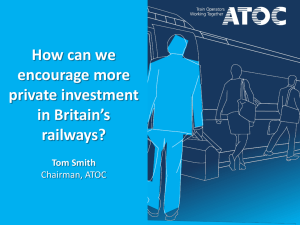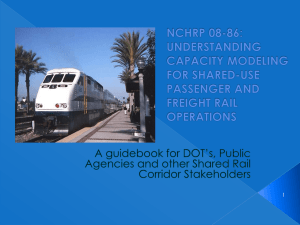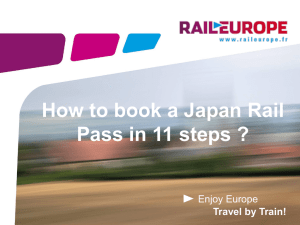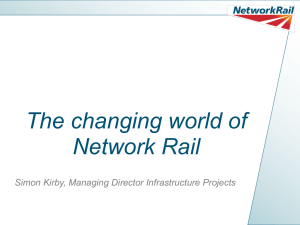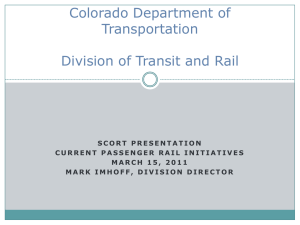Tuesday - 900-1015 Page SCORT Meeting KP Final
advertisement
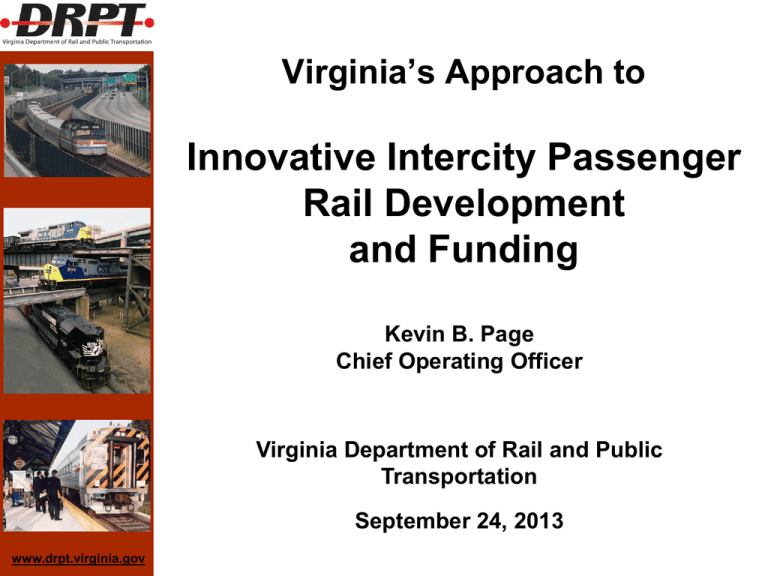
Virginia’s Approach to Innovative Intercity Passenger Rail Development and Funding Kevin B. Page Chief Operating Officer Virginia Department of Rail and Public Transportation September 24, 2013 www.drpt.virginia.gov High Speed Rail Map 2 3 Federal High Speed Rail Projects 4 4 Amtrak Corridor Services –PRIIA NEC Spine: Excluded from Section 209 State Supported Routes: Require consistent agreements under Section 209 System Corridor Routes: Require new agreements, no state support in place Mixed State/System Routes: Requires conversion of system trains to state support 5 What do These Map Segments Represent for Virginia? Richmond to Washington, D.C. $1.8B – MAS 90 MPH Richmond to Hampton Roads $.5B – MAS 90 MPH Richmond to Raleigh $2.4B cost, $1.3B in VA – MAS 110 MPH VA must pay for all regional Amtrak service or lose six daily round trip trains 6 State Rail Agency Challenges Justify the Decision to Pay for It Balancing the perception of what should be achieved with the reality of what can be achieved. Wait for the federal program or go it alone. – Advancing intercity passenger rail incrementally utilizing limited state resources while continuing project readiness in preparation for a sustainable federal program for high speed intercity passenger rail development Retaining existing regional intercity passenger rail in the advent of PRIIA Section 209 – Virginia is one of a small handful of states that appear ready for October 2013 implementation To find the money, one must find their place in the transportation arena. 7 Virginia Highway and Rail Miles Competition or Part of an Overall Transportation System? 80,000 69,114 70,000 57,865 System Mileage 60,000 50,000 40,000 30,000 20,000 10,000 7,191 4,395 3,929 3,365 0 1930 1970 Rail Miles 2007 Highway Miles 8 Virginia Gets It Virginia’s Passenger and Freight Rail System is perceived as an integral part of the Commonwealth’s Transportation System Virginia has some of the most innovative codified rail funding programs in the United States – 1987 Rail Industrial Access Fund – HCF funded annually – 2005 Rail Enhancement Fund – dedicated funding – 2007 Rail Preservation and Development Fund (budget funded since 1992) – 2008 Rail Capital Bonds for REF and RPF – 2011 Intercity Passenger Rail Operating and Capital Fund (dedicated funding provided 2013) Virginia initiated intercity passenger rail service starts – 2009 – Lynchburg – 2010 – Richmond – 2012 – Norfolk – Within 4 years – Roanoke – Within 10 years – Trains 2 and 3 Norfolk Through the support of the State Legislature and the Administration, DRPT continues to position Virginia to achieve a greater vision on passenger and freight rail development. 9 Setting Up a Passenger Rail Program PRIIA 2008 Section 209 was a game changer for Virginia DRPT reacted quickly to begin setting up a funding program for regional intercity passenger rail and capital development of expanding conventional service and higher speed rail Virginia followed a three step approach to program development – SJ63 2010 called for DRPT to study and recommend funding strategies for state sponsored intercity and high speed passenger rail. Report published as Senate Document 14 of the VA General Assembly – 2011 DRPT authors legislation to establish the Intercity Passenger Rail Operating and Capital Fund (IPROC) and provided 2 years of funding for stop gap security to start Amtrak Section 209 funding – 2013 Landmark transportation funding legislation includes dedicated funding for IPROC 10 2013 Transportation Funding Bill HB2313 – Finance Intercity Passenger Rail Impact to DRPT – $300 million for the Dulles Metrorail Corridor Extension – Designated revenue source for Intercity Passenger Rail Operating and Capital Fund (IPROC) – Approx. $44.3M in the first year • Operating funds for continued and expanded Intercity Passenger Rail Service – Extension of passenger train service to Roanoke – Addition of trains 2 & 3 for Norfolk-Washington route • Capital funds for Intercity Passenger Rail Projects – Track Performance Improvements » Newport News-Richmond » Richmond-Washington – Increase of transit funding • Approximately $66.5M in the first year – Funding - 3% statewide sales tax increase and increased MTTF dollars from the TTF 11 2013 DRPT Legislative Actions HB1828 – Position the Agency Codifies the Supreme Court decision that a state’s rail system does provide a highway benefit Authorizes the Department of Rail and Public Transportation to acquire and hold title to land for constructing rail infrastructure Currently DRPT may lease, construct and improve rail infrastructure, but is not expressly authorized to own rail infrastructure. This legislation adds the authority for DRPT to hold title to abandoned rail way and to preserve it for future rail development. 12 Virginia Rail System – – Two passenger rail operators – Amtrak and Virginia Railway Express Eleven freight railroads – • • Two national Class I Railroads: Norfolk Southern and CSX Nine local shortline railroads 13 Corridor Passenger and Freight Rail Initiatives 14 Shortline Initiatives Rail Preservation and Development Program 9 shortlines in VA Provide “last mile” service Maintain FRA class 2 standards – safety, signaling and reliability 15 Passenger Rail Service In Virginia Present and Future Amtrak VA – Lynchburg, Richmond/Norfolk Amtrak Regional – 2 Newport News, 2 Richmond All go into Northeast Corridor All same seat to Boston Amtrak Long Distance – Cardinal, Crescent, Carolinian, Palmetto, Silver Meteor, Silver Star Auto Train 16 Virginia Regional Amtrak Passenger Service Projected Population Areas 17 Set the Vision and Show How to Get There States Need a Rail Plan and a Resource Allocation Plan Virginia’s Rail Plan is accompanied by a Resource Allocation Plan Rail Plans need a vision of greater than the Six Year Improvement Program – Constrained Six Year Program – 2035-2040 longer range vision plan of projects 18 Virginia State Rail Plan Intercity Passenger Rail Amtrak Virginia Near Future - 1 Lynchburg train extended to Roanoke (approx. 2016 - 2017) - 2 Richmond trains extended to Norfolk (approx. 2022) Amtrak Virginia Future - 1 new train to Lynchburg - 1 Roanoke train extended to Bristol - 1 Lynchburg train extended to Roanoke - 1 new train Richmond to Lynchburg Richmond to Hampton Roads Passenger Rail – 1 new to Newport News + 6 total Norfolk from Richmond SEHSR – 4 new trains DC to Raleigh 19 Virginia’s Second Path Federal Funding In order to achieve the vision for higher speed passenger rail in Virginia, a strong federal participation is necessary, but comes with requirements: – Lengthy federal environmental process can require more than eight years to complete – Performance requirements are difficult to achieve without full funding for corridor-wide improvements – Opportunities to apply for funding limited and may not coincide with planning/construction phases State-funded projects can advance faster, but not sufficient state funding available to meet all needs On some projects, states may need to join forces 20 Virginia-North Carolina Interstate High-Speed Rail Compact Two States Join Forces Established in 1994 in VA by SB 126 2004 and in NC by NC General Statutes - Chapter 136 Article 18 § 136-220 Made up of ten members of the VA and NC legislature To study, develop, and promote a plan for the design, construction, financing, and operation of interstate high-speed rail service through and between points in the Commonwealth of Virginia and the State of North Carolina and adjacent states To coordinate efforts to establish high-speed rail service at the federal, state, and local governmental levels To advocate for federal funding to support the establishment of highspeed interstate rail service within and through Virginia and North Carolina and to receive federal funds made available for rail development 21 Points of Discussion for Passenger Rail Development and Funding What is the policy for passenger rail development and funding for your state? Affordability of conventional incremental service development VS high speed rail development – What can you deliver? – State Program • Establish a good working relationship with railroads by establishing Framework Agreements • Incremental State service can be implemented quickly • Track capacity is achieved through agreements, service is operated by Amtrak under Amtrak’s access and performance agreements already in place – Federal Program • 20% capital match to FRA grants, 20 year Maintenance of Project Commitment, 20 year commitment to fund additional service operations, Corridor Service Development Programs VS individual projects (commitment to build entire corridor VS segments) • Risk/Payback - Performance payback (on time performance), loss of passenger service payback (all Amtrak service ceases), and failure to provide additional service payback (additional trains committed) 22 To Get to the Funding, You Need a Plan Need for a National Rail Plan – Guiding principles on defining passenger and freight rail development • High speed intercity passenger rail and at what speed – is it comingled with freight as high capacity corridors or right-of-way of its own? • What is the federal role and participation both in planning and function? What is the definition of your state’s passenger rail corridors? – Do your corridor improvements benefit other states or are they joint freight and passenger rail projects? Be able to answer the sequencing of individual projects and who will pay for the improvements. 23 Key Points Regarding Funding Innovative financing for passenger rail begins with trust of the administration and legislature and the ability to deliver. Virginia is competing nationally for federal funds but has some advantages: – Framework agreements in place with railroads – Agreement with Amtrak for state sponsored passenger rail service under PRIIA Section 209 – State funding program for rail capital and intercity passenger rail operating projects – VA High Speed Rail Corridor program links the Northeast Corridor Virginia has PPTA and PPEA business models in place for innovative private and public venture partnerships. Virginia has sustainable rail programs that continue to provide and expand passenger rail. 24 Thank You! 25

